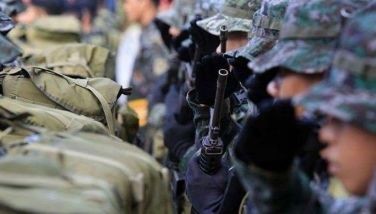COVID-19 cases drop in Metro Manila

But rise in Central Visayas
MANILA, Philippines — Fewer people are getting infected with coronavirus disease 2019 or COVID-19 in Metro Manila, but the deadly virus is now spreading faster in Central Visayas.
The “COVID-19 Philippine Situationer” issued by the Department of Health (DOH) yesterday showed that from 13 percent, the proportion of COVID-19 cases in Central Visayas went up to 24 percent starting May until June 12.
Central Visayas includes the provinces of Bohol, Cebu, Negros Oriental and Siquijor.
The situationer was released as the nation awaits President Duterte’s decision today on whether to further ease COVID quarantine restrictions in Metro Manila and several other areas.
“On May 27, 24 percent or 120 of the 503 confirmed COVID cases reported for the day came from Central Visayas,” DOH noted.
With a total of 3,999 cases, DOH said Central Visayas holds the second highest reported number of COVID-19 infections in the country.
The health agency said the National Capital Region (NCR) accounted for the biggest number of cases among all regions, although its proportion has significantly decreased in the past weeks.
From January to May, the NCR accounted for 63 percent of cases nationwide. The figure dropped sharply to 36 percent from May 20 to June 12.
DOH said Mimaropa – comprising the provinces of Mindoro, Marinduque, Romblon and Palawan – has the third highest with 1,943 confirmed COVID-19 cases.
The proportion of COVID-19 cases in Mimaropa has also dropped, from 11 percent to three percent.
Fresh and late reports
The DOH said 539 additional cases brought to 25,930 the total number of confirmed COVID-19 cases nationwide. Of the additional cases, 366 are fresh and 173 are late.
Metro Manila accounted for 153 of the fresh cases and Central Visayas recorded 110. Of the late cases, 142 came from Metro Manila and only five from Central Visayas.
The DOH said the number of recoveries had reached 5,954, including 248 patients who had just recovered from the virus. COVID-related deaths rose to 1,088 with the inclusion of 14 more fatalities.
Fatality rate dropping
Despite the spikes in number of deaths due to the infection in the past two days, DOH yesterday reported a continuing decline in the country’s COVID-19 fatality rate.
“From April to May, the percentage of death in the country due to COVID has gone down from 5.52 percent to 4.24 percent as of June 13,” Health Undersecretary Maria Vergeire said in a virtual public briefing.
Vergeire further noted that the Philippines’ COVID-19 case fatality ratio is also lower than the global average of 5.6 percent and compared to other countries in Asia.
Epidemiologist and Interagency Task Force (IATF) technical working group member John Wong said there was a spike in the number of COVID-related deaths in the past two days.
However, Wong said the increase does not necessarily indicate more COVID-19 patients are dying.
“The recent increase has been due to late reports as the median deaths remain at nine per day,” Wong noted.
According to Wong, the COVID-19 case fatality ratio in the country has been declining since April until the past two day spikes of 22 and 16 cases.
“These episodes are actually late cases. The 22 deaths did not happen yesterday,(most) occurred in the past several months,” Wong pointed out.
Of the 22 deaths, only four occurred in June while the rest happened in past months.
Wong said there has been delay in the reporting of deaths, though it has improved from a high 32 days to seven days delay in the actual date of death to reporting.
He attributed the delay in reporting to the long process of gathering data from local government units (LGUs).
“The actual death has to be reported to the LGUs then to regional offices before the DOH. The data has to be validated if the death was really due to COVID, and that is causing the delay,” Vergeire explained.
Health or economy?
President Duterte is expected to announce today his decision on the fate of Metro Manila, a product of what Malacañang called a “gamble” that will require him to contain the coronavirus while promoting economic activity.
Some sectors are hoping that Metro Manila – home to more than 12 million people and source of more than a third of the Philippines’ gross domestic product – will shift from general community quarantine (GCQ), which was imposed on June 1, to the most relaxed modified general community quarantine (MGCQ) on June 15, so more businesses can resume operations.
However, such hopes are being dashed by the continuous rise in the number of persons infected with the virus.
“Based on the numbers in Metro Manila and Cebu, it seems that it is not yet appropriate to relax (the quarantine measures). But as I said earlier, it would be up to the President because he would balance the economy and the capacity to provide critical medical care to those who will get sick,” presidential spokesman Harry Roque told radio station dzBB last Saturday.
“But it’s a gamble and we will just let the President make the decision,” he added.
Mayors to let IATF decide
The mayors of 16 cities and one municipality in Metro Manila would leave to the IATF the decision on the fate of the capital region, an official said.
“Whatever the decision of the IATF, they will follow,” said Metropolitan Manila Development Authority (MMDA) general manager Jose Arturo Garcia in an interview with radio station dzBB yesterday.
“We trust the wisdom of the IATF… we will follow that. Whatever happens, we are ready,” he added in a mix of Filipino and English.
While the 17 mayors that make up the Metro Manila Council – the MMDA’s policymaking body – met last Saturday night, there was only little discussion on the region’s quarantine status beyond today, Garcia emphasized.
“We talked about the next scenario, whether GCQ or MGCQ… the LGU has the power to declare lockdown on a barangay or a zone, and let the economy work for the rest,” he said.
The mayors instead talked about plans during the continued lockdown, like the establishment and connection of more bicycle lanes around NCR, Garcia said. Ghio Ong, Alexis Romero
- Latest
- Trending





























